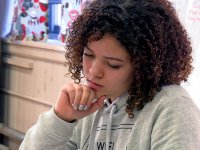7 Reflection Tips for Assessment, Empowerment, and Self-Awareness
How to model and guide students toward a more reflective approach to their projects, grades, actions, and reactions.
Your content has been saved!
Go to My Saved Content.Reflecting takes many forms in the classroom, and it is an integral and indispensable part of education. Great teachers reflect on their daily practice and tweak their units, interactions, and attitudes, both at the end of a class and in the midst of their work.
In the same way, students need to reflect on their actions and their work in order to build their classroom community and increase their own knowledge and skills. If you want to integrate reflection into your teaching practice, here are seven tips that you can start implementing in your classroom now.
1. Reflect With Shout-Outs
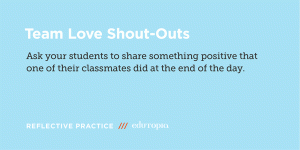
In an English classroom in my building, the classes use TL (Team Love) shout-outs. At the end of class, kids are asked to shout out one positive thing someone else did. “TL to Carla for lending me a pencil!” or “TL to Kofi for explaining his quote really well” are surface observations, but they’re also kernels of reflection.
2. Reflect Through Writing
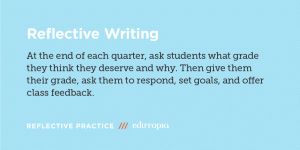
The most common form of reflection is a simple written response. Students can reflect on projects, grades, actions, and reactions. I use a reflection at the end of every quarter where I ask my students what grade they think they deserve and why, and then I give them their grade and ask them to respond, set goals, and offer any comments on the class.
I’m constantly amazed by how honest and accurate my students are. Most of them will predict within five points of their actual grade and be right on target with what they need to work on. Sometimes this practice also provides key insights, such as one student writing about having a hard time at home and how it was affecting her grade, or another student setting a goal to check off every item on his agenda each day before leaving school.
3. Model Reflective Learning With Pluses and Deltas
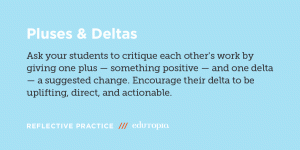
Pluses and deltas take the place of pros and cons. A pro and con chart points out strengths and weaknesses, giving equal weight to each. For young people, pointing out weaknesses can be devastating, especially if there are more cons than pros. Using pluses and deltas instead phrases the conversation in terms of things a student did well and things that need to change. It’s a subtle but pervasive shift that’s especially helpful when students offer feedback to their peers, and it’s a great tool for your students to model reflective learning.
Each week in my science class, a different student presents a Science Friday project. At the end, four peers offer one plus and one delta each. These comments highlight the positive and then suggest a change, making the feedback uplifting, direct, and actionable. “You didn’t speak well” is not a helpful comment. “You could speak louder next time because I missed some of your jokes” is better all around.
4. Reflect on Quizzes
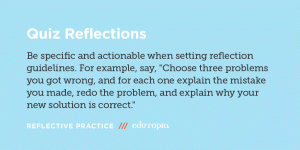
Be specific, positive, and actionable when giving guidance on reflection.
In math, students might be asked to reflect on the results of a quiz. Simply saying, “Reflect on your work,” isn’t enough. Instead, you can say, “Choose three problems you got wrong. For each one, explain the mistake you made, redo the problem, and explain why your new solution is correct.” This focuses the students to reflect on one specific aspect and then gives them a specific format for the reflection. As the year goes by, less and less explanation is needed. If students recognize this format and begin to internalize it, they can use it as a baseline for what reflect means in the future.
5. Reflect on Behaviors
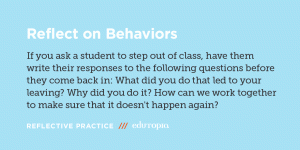
When a class runs particularly well, I will often end by asking for reflection on why everything went so smoothly. On the other hand, if I ask a student to step out of class, I ask them to write a reflection:
- What did you do that led to your leaving?
- Why did you do it?
- How can we work together to make sure that it doesn’t happen again?
6. Model Reflection for Your Students
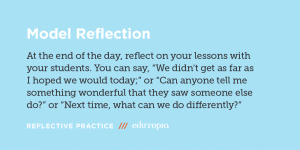
Beyond just incorporating it into your classroom as a formative or summative assessment tool, you can use your personal reflecting to make your class more transparent and your process more accessible to students. Every day brings a chance to reflect on your own lessons as a teacher with your students. The end of a period is a great time to throw out some quick comments. I’ll often say things like:
- We didn’t get as far as I hoped we would today. Does anyone have any ideas why?
- Today was great! Can anyone tell me something wonderful that they saw someone else do?
- I made a mistake. Next time, I’m going to do this differently by _____.
- I feel like we had a really great class today! I admired how all of us _____.
If students hear you reflecting honestly about your own lesson and pointing out your own successes and things to change, they’ll be more willing to do the same.
7. Reflect on Your Teaching Practice
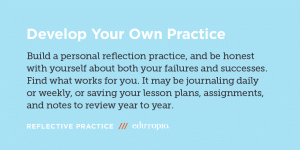
Of course, not everything needs to be shared with students. Each day in a classroom brings successes and failures of various sizes. Being honest with yourself about both is absolutely imperative.
No one will ever be a perfect teacher. From the first day to the last, we will all make mistakes. As we become more experienced educators, those mistakes will change, but they will never disappear. When I started teaching, my weakest skill was making my lessons accessible. My students often had difficulty engaging with the complexity of my classes. Now, I struggle with the opposite, challenging the high-flyers in my class while still allowing everyone to participate.
I only know this because I can look back over six years of lesson plans, saved assignments, notes to myself, and journals that I’ve written. I write to myself at least weekly, and often go back for inspiration. Some of my colleagues write daily journals. Some use blogs, Twitter, or Facebook, and others just talk a lot about their classes. Yet we all take note of our own pluses and deltas, using those to better inform our teaching.
University Park Campus School
Enrollment
252 | Public, UrbanPer Pupil Expenditures
$13794 District • $14518 StateFree / Reduced Lunch
82%DEMOGRAPHICS:
This blog post is part of our Schools That Work series, which features key practices from University Park Campus School.
